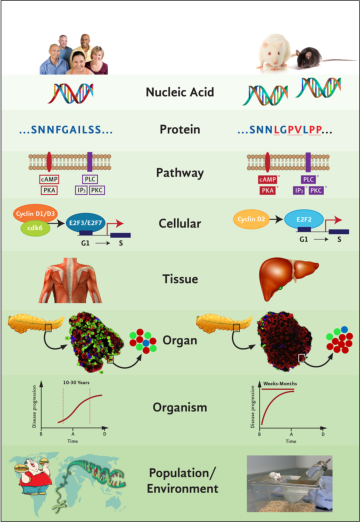
Species-specificity of glucose regulation
This figure illustrates examples of rodent-human species-specific differences that exist at every level of glucose regulation, from nucleic acid to environment level:
(1) Nucleic acid level – one insulin gene in humans vs two non-allelic insulin genes in rodents;
(2) Protein level –sequence divergence in rodents in the region that confers amyloidogenicity to human islet amyloid polypeptide;
(3) Pathway level – species disparity in KATP –independen second phase insulin secretion due to altered signaling via cAMP/PKA and PLC/IP 3 /PKC pathways;
(4) Cellular level – control of β-cell proliferation (G1/S transition) differs in humans;
(5) Tissue level – primary site of glucose clearance is skeletal muscle tissue in humans and liver in rodents;
(6) Organ level – pancreatic cytoarchitecture is strikingly different and this has functional consequences,as cell-to-cell interactions within the islet markedly vary between humans and rodents; red cells= insulin-secreting beta cells, green cells= glucagon-secreting alpha cells, blue cells= somatostatin-releasing delta cells;
(7) Organism level – progressive transition from insulin resistance to overt hyperglycemia over a long period of time in humans versus rapid disease progression and T2DM from birth often observed in rodents (B = birth, A = adult, D = death);
(8) Environment level – uncontrolled life style, epigenetic factors in humans versus controlled laboratory environments for rodents. Refer to text for further details. cAMP-cyclic adenosine monophosphate; PKA-protein kinase A; PLC-phospholipase C, IP3-inositol triphosphate; PKC-protein kinase C, KATP-ATP-sensitive potassium channel.
Tissue staining images of human and rodent pancreata are reprinted from “Seminars in Cellular and Developmental Biology, Vol 24, Caicedo A, Paracrine and autocrine interactions in the human islet: more than meets the eye,pages 11-21 (2012)”, with permission from Elsevier.
Tel : 028-8592-1823 (in China)
Tel:+1-517-388-6508 (in US)
Tel : +86 (28) 8592-1823 (outside of China)
Fax : +86-28-62491302
Zip code : 610041
Address: No.88, Keyuan South Road, Hi-tech Zone, Chengdu, Sichuan Province, China